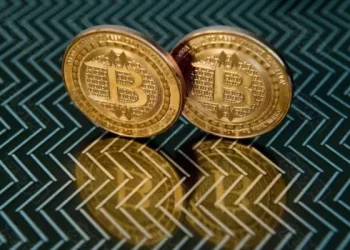Technological Foundation:
Blockchain or Distributed Ledger Technology (DLT)
One of the possible technological backbones for the digital dollar is blockchain or DLT. Blockchain is a decentralized and distributed ledger that records transactions across multiple nodes in a network. In the context of the digital dollar, each transaction involving the digital currency would be recorded on this ledger. For example, when a consumer uses the digital dollar to purchase goods from a merchant, the details of that transaction, such as the amount, the parties involved (the buyer’s digital wallet address and the seller’s), and the timestamp, would be added as a block to the blockchain.
However, it’s important to note that the Federal Reserve might not necessarily adopt a traditional public blockchain like Bitcoin or Ethereum. Instead, it could opt for a permissioned blockchain, where only authorized nodes, such as regulated financial institutions, are allowed to participate in validating and recording transactions. This would provide a balance between the transparency and security benefits of blockchain technology and the need for regulatory control and privacy protection.
Tokenization
The digital dollar would likely involve tokenization. Each unit of the digital currency would be represented by a digital token. These tokens are unique digital assets that can be transferred between different wallets or accounts. Just like physical dollars are fungible (one dollar bill is interchangeable with another), digital dollar tokens would also have this property. For instance, if a person has 100 digital dollar tokens in their wallet, each token represents an equivalent value of one dollar, and they can be used to make payments or transfer value to others in the digital ecosystem.
Digital Wallets
To store and manage digital dollars, users would need digital wallets. These wallets can be software-based, like mobile apps or web-based platforms, or hardware wallets for enhanced security. Digital wallets act as the interface between users and the digital dollar system. They hold the private keys that are essential for authorizing transactions. When a user wants to send digital dollars to another party, the wallet uses the private key to sign the transaction, verifying that the user has the authority to transfer the specified amount of digital currency. For example, a consumer using a mobile wallet app can simply enter the recipient’s wallet address, the amount of digital dollars to send, and authorize the transaction using their fingerprint or a password associated with the wallet.
Transaction Process:
Initiation of a Transaction
The process begins when a user decides to make a payment using the digital dollar. Let’s say a person wants to pay for their online shopping. They open their digital wallet app, enter the details of the merchant (usually in the form of the merchant’s digital wallet address), and specify the amount of digital dollars they want to send. The wallet then creates a transaction request, which includes the sender’s wallet address, the recipient’s address, and the amount.
Verification and Validation
Once the transaction request is generated, it is sent to the network nodes (in the case of a blockchain-based system). These nodes, which could be banks or other authorized financial institutions, verify the transaction. They check several aspects, such as whether the sender has sufficient funds in their digital wallet (by looking at the balance recorded on the ledger), the authenticity of the sender’s wallet and its associated keys, and the integrity of the transaction details. If it’s a permissioned blockchain, only nodes with the appropriate permissions can participate in this verification process.
In addition to the basic checks, there may also be compliance checks related to anti-money laundering (AML) and know-your-customer (KYC) regulations. For example, if the transaction amount exceeds a certain threshold or if there are suspicious patterns in the transaction behavior, additional scrutiny may be applied to ensure that the transaction is legitimate.
Recording on the Ledger
After the transaction is successfully verified and validated, it is recorded on the ledger. In a blockchain-based digital dollar system, this means adding a new block to the chain that contains the details of the transaction. The ledger is updated across all the nodes in the network, ensuring that the information is consistent and transparent. This way, every authorized participant in the system can see the transaction history and the current balance of each digital wallet. Once recorded, the recipient’s digital wallet balance is updated to reflect the incoming funds, and the sender’s balance is decreased accordingly.
Settlement
Role of Different Stakeholders:
The Federal Reserve
Moreover, the Federal Reserve would monitor the digital dollar’s performance in the market, analyzing transaction data to understand how it is being used, who is using it, and whether it is achieving the intended goals of improving the payment system and financial inclusion.
Financial Institutions
Furthermore, banks could offer additional services related to the digital dollar, such as interest-bearing accounts for digital dollar holdings, lending and borrowing services using digital dollars as collateral, and integrating the digital dollar with other financial products and services they offer to customers.
Consumers and Merchants
Merchants, on the other hand, would benefit from faster and more secure payments. They can receive digital dollars directly into their wallets and potentially reduce the costs associated with processing traditional payments, such as credit card processing fees. Merchants would also need to update their payment systems to accept digital dollars, which might involve integrating with payment gateways or wallet providers that support the digital currency.
Security and Privacy Considerations:
Security Measures
Regular security audits and updates would be conducted to identify and patch any vulnerabilities in the system. Additionally, backup and recovery mechanisms would be in place to ensure that in case of any technical failures or disasters, the digital dollar holdings and transaction history can be restored.
Privacy Protection
However, privacy also needs to be balanced with regulatory requirements. AML and KYC regulations require financial institutions to collect certain information about users to prevent illegal financial activities. The digital dollar system would need to find a way to comply with these regulations while still respecting the privacy rights of individuals, perhaps through secure and encrypted data storage and sharing mechanisms that limit access to only authorized entities.

















